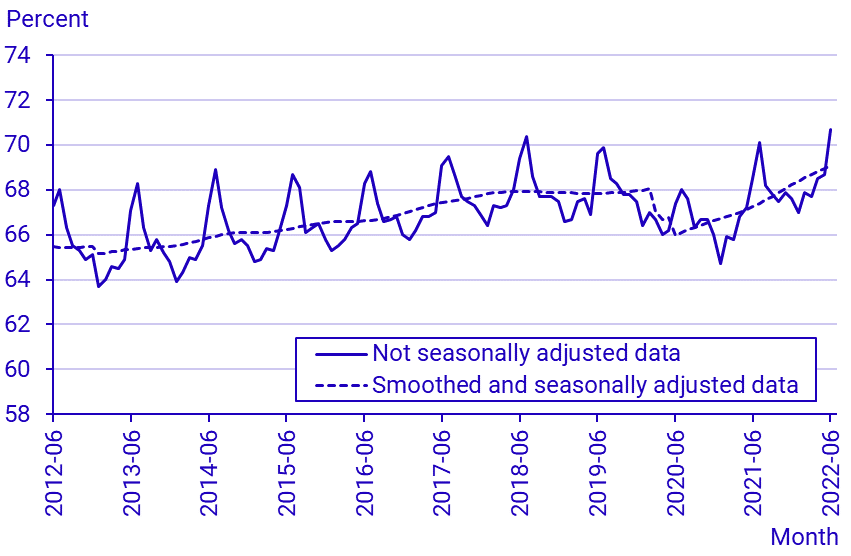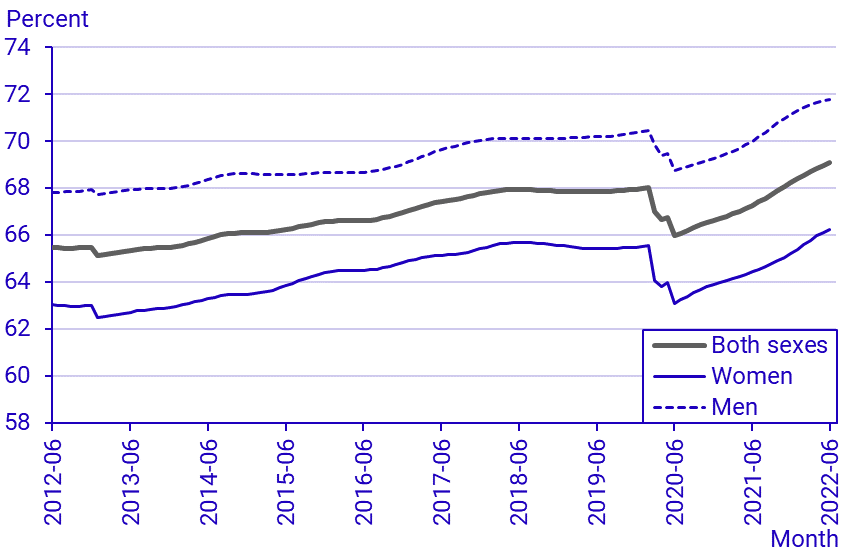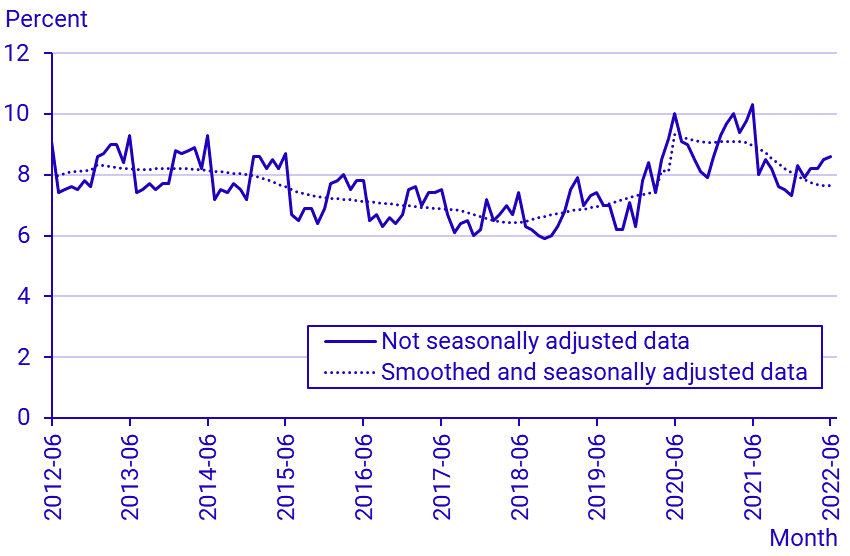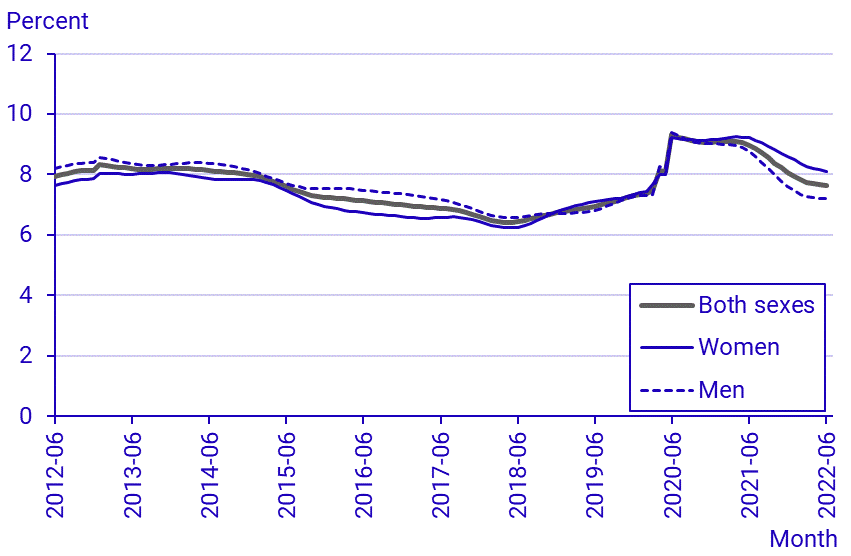Labour Force Surveys (LFS), June 2022
Employment is increasing for young people
Statistical news from Statistics Sweden 2022-07-29 8.00
In June 2022, there were 5,333,000 employed people, not seasonally adjusted. This is an increase of 188,000 persons compared to June 2021. The number of employed young people, aged 15–24, increased by 81,000 to 633,000. The average number of hours worked per week amounted to 158.7 million, an increase of 2.7 percent in calendar adjusted figures. The number of unemployed people amounted to 504,000, a decrease of 87,000 persons compared to June 2021. The unemployment rate was 8.6 percent, a decrease of 1.7 percentage points. Smoothed and seasonally adjusted data indicates an increase in employment and a decrease in the unemployment rate which amounted to 7.6 percent.
Labour force
In June 2022, there were 5,837,000 people aged 15–74 in the labour force, not seasonally adjusted, an increase with 102,000 persons. The number of women in the labour force was 2,784,000, an increase with 76,000, and the number of men was 3,052,000. The relative labour force participation rate increased by 1.0 percentage point to 77.4 percent. Among women, it was 75.1 percent, an increase with 1.8 percent, and among men it was 79.6 percent.
Seasonally adjusted and smoothed data shows an increase in both the number and share of people in the labour force compared with nearby months. The number of people in the labour force amounted to 5,639,000 people, corresponding to a labour force participation rate of 74.8 percent.
Employment
In June 2022, there were 5,333,000 employed people aged 15–74, not seasonally adjusted, which is an increase of 188,000 compared to the corresponding month a year ago. There were 2,513,000 employed women, an increase of 89,000, and 2,820,000 employed men, an increase of 100,000. The employment rate increased by 2.2 percentage points to 70.7 percent. Both for women and for men the employment rate increased by 2.2 percentage point to 67.8 percent for women, and to 73.5 percent for men. Among young people aged 15 to 24, the number of employed persons grew by 81,000 to 633,000. This corresponds to an employment rate of 54.1 percent, an increase of 5.9 percentage points. In Accommodation and food services the employment increased with 52,000 to 187,000.
Smoothed and seasonally adjusted data indicates an increase in both the number and share of employed persons compared with recent months. There were 5,209,000 employed persons, corresponding to an employment rate of 69.1 percent. That is an increase in both number and proportion compared to nearby months. Both the number and proportion of employed young people aged 15–24 increased compared with the following months. There were 526,000 employed young people corresponding to an employment rate of 45.0 percent.
Employees
In June 2022, there were 4,802,000 employees, not seasonally adjusted. This is an increase of 124,000 compared with the corresponding month last year. Among women, there were 2,360,000 employees. Among men, there were 2,443,000 employees, an increase of 74,000. There were 3,938,000 permanent employees in the same period. Among women, there were 1,893,000 permanent employees, and the number of permanent employed men was 2,045,000. There were 864,000 temporary employees. Among the temporary employees, 467,000 were women and 397,000 were men. Among young people aged 15–24, the number of temporary employees increased by 58,000 to 377,000 people.
For seasonally adjusted and smoothed data, the number of employees was 4,694,000. The corresponding figure for permanent employees was 3,944,000 and for temporary employees 751,000. Compared with previous months, seasonally adjusted and smoothed data shows an increase in the number of employees, in permanent employees and in temporary employees.
Hours worked
The average number of hours worked in June 2022 amounted to 158.7 million per week, not seasonally adjusted. In calendar-adjusted figures, this corresponds to an increase of 2.7 percent compared with June 2021.
According to seasonally adjusted and smoothed data there was an increase in the average number of hours worked compared to nearby months, which amounted to 155.8 million.
Unemployment
In June 2022, there were 504,000 unemployed persons aged 15–74 years, not seasonally adjusted. This is a decrease of 87,000 compared with June 2021. It corresponds to an unemployment rate of 8.6 percent, a decrease of 1.7 percentage points. The number of unemployed women amounted to 271,000, this corresponds to an unemployment rate of 9.7 percent. The number of unemployed men decreased by 74,000 to 233,000. This corresponds to an unemployment rate of 7.6 percent, a decrease of 2.5 percent. There were 219,000 unemployed young people aged 15–24 years, corresponding to an unemployment rate of 25.7 percent. Among unemployed young people, 93,000 persons were full-time students.
Among people aged 15–74 years, seasonally adjusted and smoothed data shows a decrease in the share of unemployed persons compared to nearby months. In June 2022 there were 431,000 unemployed persons, which corresponds to an unemployment rate of 7.6 percent. Even among young people aged 15–24, seasonally adjusted and smoothed data shows a decrease in the share of unemployed persons compared to nearby months. The number of unemployed young people amounted to 143,000, corresponding to an unemployment rate of 21.3 percent.
Unused labour supply
Unemployed people, underemployed people and latent job seekers together comprise the unused labour supply. In June 2022, the unused labour supply averaged 25.4 million hours per week, which is 3.9 million hours less compared to June 2021. The unused labour supply corresponds to 635,000 full-time employments with 40-hour work weeks.
There were 313,000 underemployed persons in June 2022, of which 160,000 were women and 153,000 were men. The number of latent job seekers was 236,000. Among the latent job seekers, 117,000 were women and 120,000 were men.




Next publishing will be
2022-08-18.
Feel free to use the facts from this statistical news but remember to state Source: Statistics Sweden.
